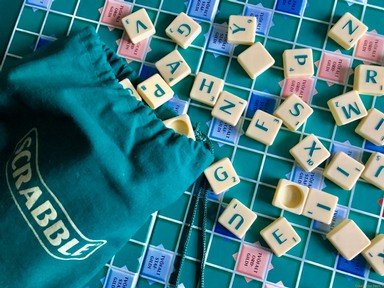Quiz Answer Key and Fun Facts
1. Let's start with a set that looks pretty normal apart from being one of the largest sets at 120 tiles. Closer examination, however, shows the only 10-point letter being a single Q with the next value being an 8, present on two each of G, H and Z. The most common letter in the set is O and 57 tiles - almost half the set - are vowels. Only 21 different letters are used at all for this quite melodious language. Which is it?
2. Weighing in at the standard 100 tiles, this set is unusual because it not only is in one of the few Asian languages using standard Latin letters, but also because almost one fifth of the set - 19 tiles - bear the letter A, making it over twice as frequent as the next most common (eight N tiles). F and Z are the ten-point tiles in this set. Which language is it used for?
3. While all letter values from 1 to 10 are used in several sets across the world (9 being the rarest), there is only one language where you will find all ten values used in the same Scrabble set. In its 104 tiles, 32 different letters are represented of whom a full twelve have only one copy. The highest values are present on the X (10), Ý (9), P (8) and Ú (8) while the A is the most frequent tile. Which language, spoken by less than one million people, is this set used for?
4. Next, I have another 100-tile set having 38 different non-blank pieces. Seven of them represent digraphs made as single tiles, showing SZ(3), GY(4), NY(5), CS(7), LY(8), ZS(8) and TY(10). A, E and K are the most common letters at only 6 pieces each. Which Eastern European language uses this peculiar tile set?
5. If you are one of the players who seem completely unable to hit those double and triple letter squares with a high-point tile, the next set may be for you. It contains only four tiles worth more than 4 points - two Cs, an X and a Z, all of which are 8 points. On the other hand, a whopping 41 of the 100 tiles are worth 3 or 4 points, so you will be racking up high word values nonetheless. Three pairs of tiles, all 4-pointers, show nonstandard letters - two with diacritical marks and the third has the AE ligature. Which language should you know to play with this set?
6. Digraphs are present in several Scrabble sets, but only one of them actually has a digraph worth a measly one point. This record belongs to the DD tile, whose four copies are supplemented with two each of FF and TH (both 4 points), a CH, an LL (both 5) and the rare NG and RH (both 10). Apart from that, the set uses only 21 different letters and ignores diacritics. Which difficult to learn language is it used for?
7. We have all learned to cross our "t"s and dot our "i"s, but of course in the English language, this only applies to lower-case letters. Thus, one would not expect a Scrabble set to contain any upper-case dotted I, but in one set, this letter exists and is in fact more frequent than the version without the dot. The set also contains the Ö (1 copy, 7 points) and Ü (2 copies, 3 points), but is definitely not for German. What language is it from?
8. We already had a set with very few 1-point and high value letters, now here is the opposite: A full twelve tiles show an 8, 9 or 10. They are H, J, X and Z (10 each) as well as two copies each of B, G, (both 9), F and V (both 8). On the other hand, the list of interesting tiles almost ends here already as 75 of the 100 tiles (11 different letters) show a 1. Which language has this extreme distribution of letters?
9. Could there be a set where the most common letter is a consonant? The answer is yes and no - a consonant is never the sole most frequent letter, but in one set, a full three consonants (R, S and T) share this honor with the A. All of them have eight tiles each. The rare letters are Z (10 points), C, X (both 8), J and Y (both 7). Which North European language is this set for?
10. For my last game, I have a handmade set with relabeled tiles, made according to the specifications for tournaments in its language. Its interesting letters include nine 1-point Vs and three Qs, each worth only three points. On the other hand, F and H are the only high-scoring letters at 8 points each. There are only 19 different letters, too, notably completely missing the U. What language do I need to brush up on to play with these tiles?
Source: Author
WesleyCrusher
This quiz was reviewed by FunTrivia editor
ozzz2002 before going online.
Any errors found in FunTrivia content are routinely corrected through our feedback system.
